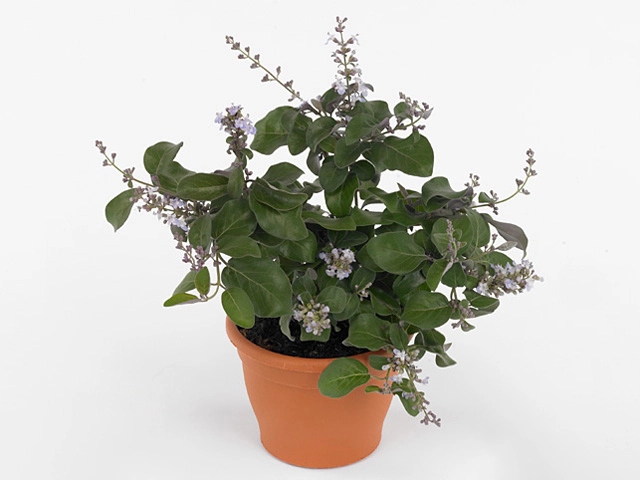Vitex rotundifolia

| Leaf tip | Pointed/acute |
| Flower type | Single |
| Leaf margin | Entire |
| Flower scent | Unscented |
| Flower color | Blue-light violet blue-091B |
| Leaf, general shape | Elliptic / oval |
| Flower diameter | 1 - 10 mm |
| Plant height | 10 - 20 cm |
| Flower length/hight | 1 - 10 mm |
| Inflorescence | Raceme |
| Structure (tissues) | Subshrubby/semi-shrubby |
| Leaf size | 3 - 4 cm |
| Plant, growth type | Erect |
| Leaf, main color | Dark green |
| Leaf colour, pattern | Unicolored |
| Flower color distribution | Unicolored |
Vitex rotundifolia, also known as the Beach Vitex or Round-Leaved Chastetree, is a subshrubby plant that belongs to the Verbenaceae family. It is a small, erect plant that typically reaches a height of 10-20 cm. The leaves of Vitex rotundifolia are elliptic or oval in shape with a pointed or acute tip. They have a dark green color and a smooth, unicolored appearance.
The flowers of Vitex rotundifolia are single and produce a subtle scent. They can range in color from blue to light violet-blue, with a specific shade of 091B. The flowers have a diameter of 1-10 mm and a length or height of 1-10 mm as well. They are arranged in racemes, a type of inflorescence where the flowers are borne on peduncles along a central axis.
The overall structure of Vitex rotundifolia is considered subshrubby or semi-shrubby, meaning it has characteristics of both a shrub and herbaceous plant. This plant is commonly found in coastal areas, particularly in sandy or rocky beaches. It is well-adapted to tolerate salt spray and strong winds.
The leaves of Vitex rotundifolia have a size range of 3-4 cm and have entire margins, meaning there are no visible teeth, lobes, or serrations along the edges. The plant grows in an erect manner, with the stems standing upright and firm.
The flowers of Vitex rotundifolia are unicolored, without any visible color variation or patterns. The flowers are pollinated by insects, particularly bees and butterflies, which are attracted to the plant's nectar and pollen. They play a crucial role in the reproduction and genetic diversity of the species.
Overall, Vitex rotundifolia is a charming and petite plant that graces coastal areas with its delicate blooms and rounded leaves. Its ability to thrive in harsh environments makes it a valuable addition to beachside gardens and natural habitats. The unicolored flowers add a touch of elegance and tranquility to any landscape, attracting pollinators and providing a habitat for various wildlife species.